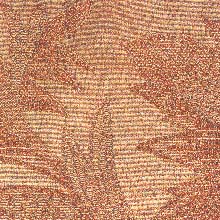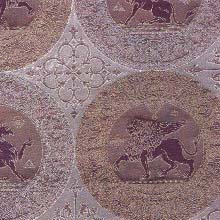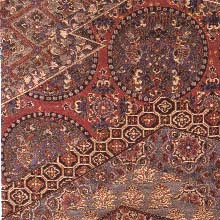Weave (p. 103 )
1. Produced in Kamigyoku Kyoto City, Kyoto-Fu.
2. Characteristics: The name "Nishijin"(west position) came about because these gorgeous fabrics were produced in the area in Kyoto where the position of an army, then called "West Army" was in a civil war("Onin no Ran") which lasted 10 years, ending in 1477. As it is woven with threads of many colors,"Nisahijin Ori" is a gorgeous and brilliant fabric representative of Japanese textiles. More than 150 ways of weaving are used to achieve the varieties of fabrics: in general, however, 2 kinds;"Mon Ori" and "Tsuzure Ori." As far as the sashes are concerned, "Nishijin" is one of the 3 cities producing quality sashes.
3. Uses: Sashes, clothing, gold brocades, thick curtains, interior and textile art.
4. History: The history of "Nishijin Ori" is only 500 years old, but that of silk fabrics in this area is older and with much ups and downs. A Korean named Hata, with some 1,000 Koreans settled here and started sericulture and silk weaving in the 5th or 6th century. When the capital was moved here in 794 and the Fabric Office was established, Kyoto developed into a flourishing center of fabrics for imperial families, nobilities and court officials. Such quality fabrics were woven as "Ra" and "Sha"(gauze), "Aya"(figured twill), "Kome Ori"(kind of gauze) and "Nishiki"(brocade).
In the Muromachi Period, Kyoto became a battlefield as a civil war broke out. Weavers left here for Nara and Sakai but came back after the war. They established a weaverユs guild, resuming the production here. As the Ashikaga Shogunate protected it, Nishijin weaving reached an extensive development. In the Azuchi Momoyama Period(1568-1600) production of many kinds of weaving was possible due to the patronage of a warrior ruler Toyotomi and trade with China. Through the Chinese came the technique of weaving "Kinran"(rich brocade with gold threads), "Donsu"(damask) and "Shusu"(satin).
The weaving industry declined off and on in 1730 and again in 1788 due to a big fire in Kyoto. After that, however, the industry was revived because of the weaversユ efforts in developing the techniques and the quality and also because the townsmen class, now rich, supported the industry. Thus, Nishijin became the center of quality fabrics. The industry continued to prosper even after the Jacquard machine was imported in the Meiji Period. Nishijin has been the greatest center of the silk fabric industry. "Tsuzure Ori" is a technique in weaving designs in plain weaves with thick twist yarns as weft. A sketch of the design is placed under the warp in the loom and the weaver puts in the weft while looking at the design through the warp. The weft in general is woven by using a reed with the width of the fabric. In "Tsuzure Ori," however, colored threads, including gold and silver, are woven into the design. The weaversユ nails are shaped like saw teeth and used for fixing the threads into the design. Therefore, "Tsuzure Ori" is also called "Tsume(nail) Tsuzure."





